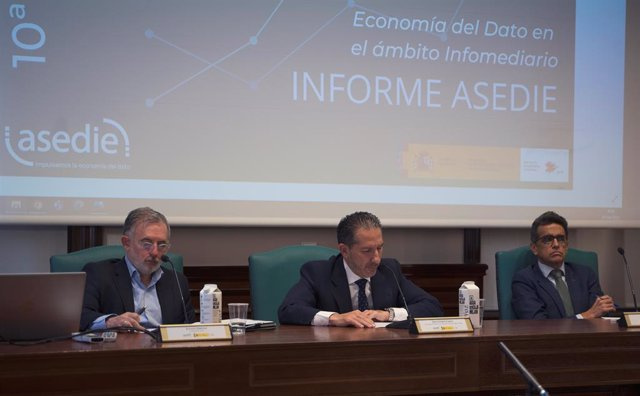(Information sent by the signatory company)
Society lives in the data age. Information has ceased to be considered an important resource to become the resource par excellence and the Data Economy in its Infomediary field has become one of the most influential factors of this Ecosystem.
Madrid, December 23, 2022. The pace at which the reality of digitization, artificial intelligence and the Internet of Things are evolving is increasing, more immediate. Consequently, the impact that these transformations have on the economic system have inevitably turned the Data Economy in its Infomediary sphere into one of the most influential factors in the economy.
It is necessary to be aware of the importance that open data has in today's world, to understand what its true value is based on, both economically and socially. The term open data refers to a philosophy, which entails a practice applied to the real world, which seeks to make certain types of data freely available globally.
This philosophy has found its maximum development in the digital age in which an infinite amount of data is produced every second: big data, real-time data, data lakes, artificial intelligence... This is why the value of data, although certainly very difficult to measure, is completely evident on a day-to-day basis.
Although, in order to try to translate this value into numbers, the European Union, in the European data strategy, estimates that, by the year 2025, the value of the data economy in the EU27 will be 829,000 million euros compared to 301,000 million euros in 2018 and forecasts that the number of millions of data professionals will double in 2025, reaching 10.9 million workers.
Access to valuable Public Sector information creates many jobs which, in turn, can lower the unemployment rate and boost a nation's economy. In other contexts, the data even acquires life-saving value, allowing emergency services to reach the scene of an incident quickly. For all these reasons, after being aware of the magnitude of the talk when referring to the value of open data, work must be done to ensure that these are updated, standardized, structured, normalized, downloadable, reusable, that include a unique identifier and that they are permanent in time to truly be able to extract the maximum value from open data.
ASEDIE's role in a world of data
In 1999, in the midst of the incipient context of the current world of data, ASEDIE was born, with the aim of associating those companies or public organizations that, precisely, had the objective of using, reusing and distributing information and data.
It was through his collaboration with the Public Sector that he realized the existence of a general ignorance regarding the Infomediary Sector and its value. For this reason, for ten years the Asedie Report has been prepared and published, which offers data to the exact cent, however, with a lag of more than a year, given the impossibility of accessing updated information beforehand. The report for the year 2022 identifies 701 companies, with a total of 22,638 employees, and more than 200 million euros in sales. Comparing the data with the first report of 2013, in which 444 companies with 9,971 employees and almost nine hundred million in billing were identified, it can be seen that it is a healthy Sector, in constant growth and with a good projection for the future.
As has been qualified, calculating and determining the value of the data is a very difficult task to measure as well as being very necessary to make today's world work. The European Data Portal began in 2015 the preparation and publication of a report on the economic impact of open data in Europe. The second edition, published in 2020, forecasts that the value of open data, by 2025, will reach a development of between 199,510 and 334,210 million and in relation to open data employees, the figures from the ASEDIE Report were used as the basis for to be able to make estimates regarding the number of employees in this area in Europe. Thus, in 2019 it is estimated that the number of employees was around 1.09 million people, while in 2025 the forecast is between 1.12 and 1.97 million employees.
Companies associated with Asedie
Asedie's associates are in charge of collecting, analyzing, transforming and processing information from the public and/or private sector to create value-added products for third-party companies or citizens in general, serving, among other functions, for effective decision-making.
The importance and scope of the services that these companies provide to the market and to the general public are reflected in the volume and type of companies and/or entities that use their various services and products, among others are: all IBEX35 entities, financial entities that operate in the national territory and partly abroad, public administrations, SMEs and individual entrepreneurs... as well as any citizen or non-profit entities.
The Sector interacts with the rest of the sectors, generating value in many of its activities, therefore, when assessing the Infomediary Sector, it must be taken into account that it grows vertically, like the rest of the sectors, but that it also grows vertically. horizontally. Consequently, this transversality is difficult to assess, daring to say that it is practically impossible.
It must come to be understood that the numbers are not everything, although the task of translating them into indicators, such as billing and jobs, will continue to be able to continue transmitting an idea that is as reliable and tangible as possible of the real dimensions of this Sector and the companies that give it life.
Nowadays, talking about data is talking about current affairs, about the reality that surrounds citizens and companies. In the context of globalization, data is the resource that currently governs the functioning of socioeconomic systems. This is why it is pertinent as well as necessary to understand in depth and exactly what is being talked about when referring to the value of the data, being something apparently intangible and difficult to measure.
It is evident that talking about the future of the Infomediary Sector is talking about the future of data, and the future of data is none other than the direction of society, both in social and economic terms.
Contact
Contact name: Siege
Contact description: Contact telephone number: 914350354
Images
https://bit.ly/3HVjzpV
Caption: Presentation of the Asedie Report 2022 Author: Lucia Truchuelo













